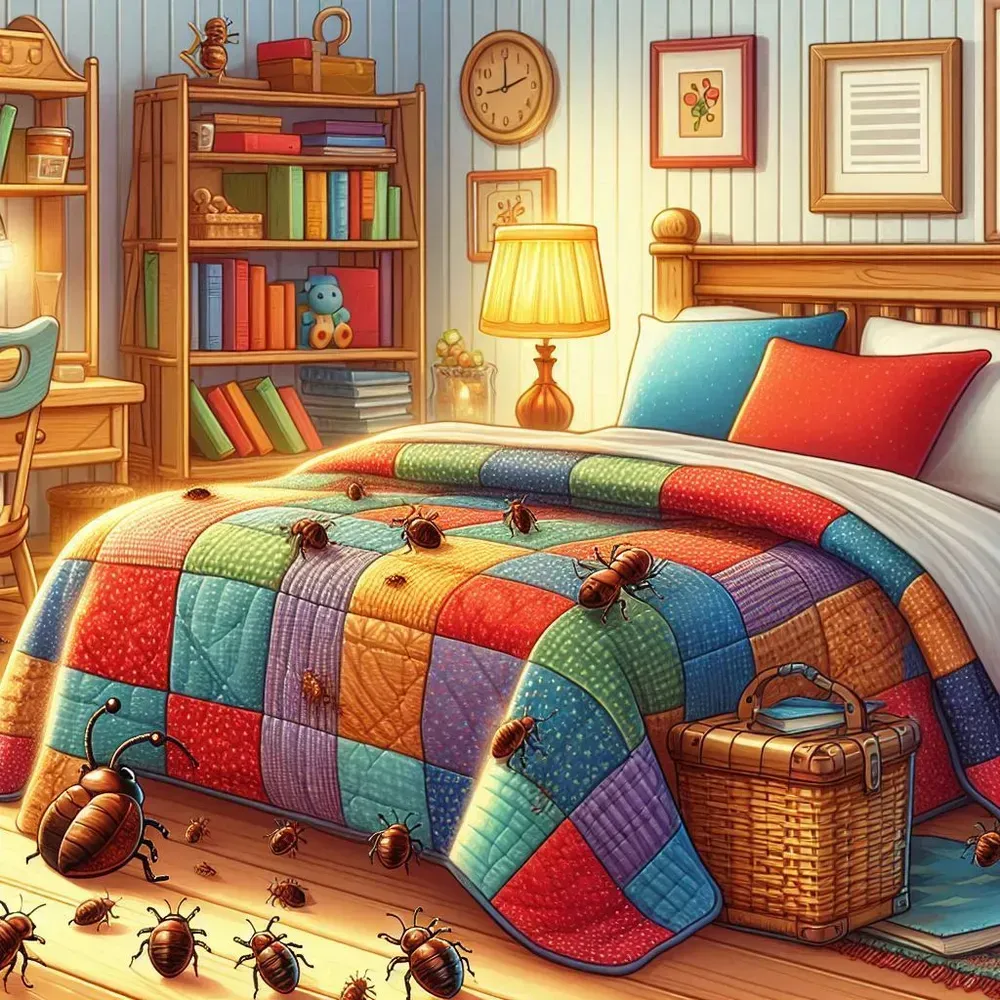10 Early Signs of Bed Bugs And How to Stop Them Naturally
Are you waking up with mysterious bites or noticing tiny bloodstains on your sheets? You’re not alone. Bed bug infestations are a growing concern, and detecting them early is key to preventing a full-blown infestation.
We understand the distress caused by these unwelcome guests, and we’re here to guide you through the process. In this article, we’ll explore the key indicators of bed bug presence. We’ll also provide you with practical, natural solutions to eliminate them.
Table of Contents

By identifying the symptoms of bed bug infestation early, you can take swift action. This protects your home and family. Let’s dive into the essential signs to look out for and how to tackle them effectively.
Key Takeaways
- Identify the common signs of bed bug infestation
- Learn natural remedies to eliminate bed bugs
- Understand how to detect bed bugs at an early stage
- Discover practical tips to prevent bed bug infestations
- Explore eco-friendly solutions for bed bug removal
Understanding the Bed Bug Problem
Bed bugs are becoming more common, and it’s important to understand why. These pests are not just annoying; they can harm our health and quality of life. Knowing what causes this problem helps us fight it better.
Why Bed Bug Infestations Are on the Rise
Another key factor is development of resistance to insecticides. Bed bugs have grown resistant to some chemicals, making treatments less effective. This, along with a lack of knowledge about bed bugs, has spread them further.
The Health and Psychological Impact
Bed bugs can harm our health and minds. Their bites can cause skin irritation, allergic reactions, and even anaphylaxis. The stress of living with them can lead to sleeplessness, anxiety, and depression.
The psychological effects are just as important. The shame of having bed bugs can make people feel isolated. It’s important to remember that anyone can get bed bugs, no matter how clean or wealthy they are.
Early Signs of Bed Bugs: 10 Warning Indicators
Spotting bed bugs early is key to getting rid of them. They can make you uncomfortable, cause allergies, and upset you emotionally. Knowing the early signs helps you take back your home.
1. Unexplained Bite Marks in Linear Patterns
Waking up with unexplained bite marks is a common sign. These bites can be red, swollen, and itchy.

2. Rusty or Reddish Stains on Bedding
Bed bugs leave rusty or reddish stains on bedding. These stains show you have bed bugs.
3. Dark Spots (Excrement) on Mattresses and Furniture
Dark spots or specks on furniture are bed bug excrement. These spots are a clear sign of bed bug activity.
4. Bed Bug Eggs and Eggshells
Finding bed bug eggs or eggshells in hidden spots is a sure sign. Eggs are white, about 1 mm long, and found in secret places.
| Sign | Description |
|---|---|
| Unexplained Bite Marks | Linear or clustered bites on the skin |
| Rusty or Reddish Stains | Stains on bedding due to bed bug feeding |
| Dark Spots (Excrement) | Specks on mattresses and furniture |
| Bed Bug Eggs and Eggshells | Eggs or shells in cracks and crevices |
By spotting these signs early, you can act fast to get rid of bed bugs. Regular checks and staying alert help keep your home bed bug-free.
Where to Look for Bed Bugs in Your Home
Finding bed bugs early means knowing where they hide. Bed bugs love tiny spots, making them hard to spot. But, if you know where to look, you can catch them early and stop them from spreading.
Common Hiding Places
Bed bugs like places close to where they can feed on human blood. You can often find them in:
- The seams and crevices of mattresses and box springs
- Behind headboards and bed frames
- In cracks and crevices of furniture, near beds
- Under carpets and rugs, around beds
- Behind wallpaper and molding
“Bed bugs can hide in incredibly small spaces, so a thorough inspection is critical.” A pest control expert notes,
“The key to effective bed bug management is early detection.”

How to Conduct a Thorough Inspection?
To find bed bugs early, inspect your home, focusing on sleeping areas. Here’s how:
- Remove bedding and check mattress seams, box spring, and bed frame.
- Use a flashlight to explore cracks and crevices.
- Inspect behind headboards, nightstands, and other furniture near the bed.
- Look under carpets and rugs, around the bed.
- Search for signs of bed bugs, like live bugs, eggs, or dark spots (excrement).
By following these steps and knowing where to look, you can spot bed bugs early. Then, you can act fast to get rid of them.
Natural Methods to Eliminate Bed Bugs
We’re looking to nature for ways to get rid of bed bugs without harming the environment. Many homeowners want to avoid chemical treatments for health and environmental reasons.
Heat Treatment Techniques
Heat is a powerful tool against bed bugs. They can’t survive temperatures over 120°F (49°C). Simple actions like washing bedding on high heat can help.
Tips for Effective Heat Treatment:
- Use a steam cleaner to treat areas where bed bugs hide, such as mattress seams and behind wallpaper.
- Wash and dry clothing and bedding on the highest heat settings.
- Consider renting a portable heat treatment unit for severe infestations.
Essential Oils That Repel Bed Bugs
Certain essential oils can keep bed bugs away. They’re not a cure-all but can be part of a larger plan. Lavender, tea tree, and peppermint oils are among the most effective.
How to Use Essential Oils:
- Mix a few drops of essential oil with water and spray it around the bed and other areas where bed bugs are present.
- Add essential oils to your laundry to help repel bed bugs from clothing and bedding.
Diatomaceous Earth and Other Natural Powders
Diatomaceous earth is a safe, natural powder that dries out and kills bed bugs. It’s made from the fossilized remains of tiny aquatic organisms. When bed bugs touch it, it damages their exoskeleton, causing dehydration and death.
Application Tips:
- Sprinkle diatomaceous earth around the edges of the mattress and bed frame.
- Use a duster to apply the powder into cracks and crevices where bed bugs hide.
- Reapply after vacuuming or cleaning to maintain effectiveness.
Steam Cleaning Methods
Steam cleaning is another natural way to get rid of bed bugs. The steam’s high temperature kills bed bugs and their eggs instantly. It’s important to use steam at least 120°F (49°C) and cover all areas where bed bugs hide.
Steam Cleaning Tips:
- Use a steam cleaner with a variety of nozzle attachments to reach into tight spaces.
- Steam clean all surfaces, including mattresses, box springs, and behind headboards.
- Repeat steam cleaning regularly to ensure all bed bugs are eliminated.
Using these natural methods can help you get rid of bed bugs without harsh chemicals. Remember, it may take longer to see results, so be patient and keep at it.
Preventing Future Bed Bug Infestations
To keep your home bed bug-free, prevention is key. We’ll show you the best ways to do this. It involves being aware, keeping up with maintenance, and using natural repellents.
Travel Precautions
When you travel, watch out for bed bugs. Check your hotel room well, looking at mattress seams, headboards, and wallpaper. Keep your bags off the floor and away from walls to stop bed bugs from getting in.
- Inspect hotel rooms carefully
- Keep luggage elevated
- Wash clothes immediately upon returning home
Regular Home Maintenance
Keeping your home in good shape helps prevent bed bugs. Wash bedding on high heat often. Vacuum mattresses and furniture, and seal any cracks or crevices.
Tips for Effective Vacuuming:
- Use a vacuum cleaner with a hose attachment to get into tight spaces
- Pay particular attention to mattress seams and behind headboards
- Dispose of the vacuum bag or empty the canister after each use to prevent bed bugs from escaping
Natural Repellents for Ongoing Protection
Using natural repellents helps keep bed bugs away. Essential oils like lavender, tea tree, and peppermint can repel them. Diatomaceous earth, a natural powder, dehydrates and kills bed bugs.
Some effective natural repellents include:
- Lavender oil
- Tea tree oil
- Diatomaceous earth
By following these tips and staying alert, you can lower the chance of bed bugs in your home. Remember, prevention is everything. With the right steps, you can keep your home safe and bed bug-free.
Conclusion
Knowing the early signs of bed bugs is key to fighting them off. Look out for bite marks and rusty stains on your bedding. These signs mean you need to act fast to get rid of them.
Try natural ways to fight bed bugs, like using heat or essential oils. These methods are safer than harsh chemicals. Keeping your home clean and being careful when traveling also helps prevent bed bugs.
Stay alert and take action to keep your home bed bug-free. We give you the tools to spot, remove, and stop bed bugs. This way, you can keep your home safe and healthy for everyone.
If you are looking for a chemical free, natural bed bug or mite killer then you would love to read our review of Premo Bed Bug & Mite Killer. It is among one of the best product out in market without any side effect for both humans or pets alike.
FAQs
What are the early signs of bed bugs I should look out for?
Look for unexplained bite marks and rusty stains on bedding. Also, check for dark spots on mattresses and bed bug eggs in cracks.
How can I detect bed bugs early in my home?
Regularly inspect your home, after traveling. Look for signs of bed bug activity around beds and furniture.
What are the common hiding places of bed bugs?
Bed bugs hide in cracks, behind wallpaper, and in electrical outlets. Also, check under mattresses and box springs.
Are there any natural methods to eliminate bed bugs?
Yes, use heat treatment, essential oils like lavender and tea tree oil. Diatomaceous earth and steam cleaning also work.
How can I prevent future bed bug infestations?
Take travel precautions and maintain your home regularly. Use natural repellents to keep bed bugs away.
Can I use diatomaceous earth to repel bed bugs?
Yes, diatomaceous earth dehydrates bed bugs. Sprinkle it in areas where bed bugs are present.
What are the benefits of using essential oils to repel bed bugs?
Essential oils like lavender and tea tree oil repel bed bugs without harsh chemicals. They also calm the environment.
How often should I inspect my home for bed bugs?
Inspect your home every few months. This catches bed bug activity early and prevents infestations.
Can steam cleaning help eliminate bed bugs?
Yes, steam cleaning kills bed bugs and their eggs with high temperature. Use a steam cleaner on infested areas.
What should I do if I find bed bug eggs or eggshells?
Find bed bug eggs or eggshells? Take action fast. Wash and dry bedding, use diatomaceous earth, and steam clean the area.
Kaleem,
greenlifehub.com.

